George Washington University facts for kids
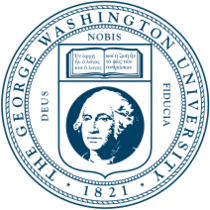 |
|
|
Former names
|
Columbian College (1821–1873) Columbian University (1873–1904) |
|---|---|
| Motto | Latin: Deus Nobis Fiducia |
|
Motto in English
|
"God is Our Trust" |
| Type | Private federally chartered research university |
| Established | February 9, 1821 |
| Accreditation | MSCHE |
|
Academic affiliations
|
|
| Endowment | $2.8 billion (2024) |
| President | Ellen Granberg |
| Provost | John Lach |
|
Academic staff
|
2,663 |
| Students | 26,457 (2021) |
| Undergraduates | 11,502 (2021) |
| Postgraduates | 14,955 (2021) |
| Location |
,
U.S.
|
| Campus | Large city, 43 acres (17 ha) |
| Newspaper | The GW Hatchet |
| Colors | Buff and blue |
| Nickname | Revolutionaries |
|
Sporting affiliations
|
|
| Mascot | George |
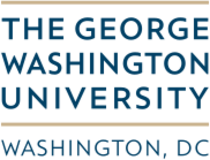 |
|
The George Washington University (often called GW or GWU) is a private university in Washington, D.C., United States. It was started in 1821 by the United States Congress and was first known as Columbian College. It was the first university created under Washington, D.C.'s rules. It is one of only six universities in the country that were started by the federal government.
GW is known as a "Very High Research Activity" university. It is also part of the Association of American Universities, a group of leading research universities. The university offers many different study programs. About 11,500 undergraduate students and 15,000 graduate students attend GW. The school's sports teams are called the George Washington Revolutionaries. They play in the NCAA Division I Atlantic 10 Conference. GW also hosts many important political events each year.
Many famous people have been involved with GW, including two former presidents, John Quincy Adams and Ulysses S. Grant. Alexander Graham Bell, who invented the telephone, was also a trustee. GW has over 1,100 former students who work in the U.S. Foreign Service. This means many GW graduates become diplomats for the U.S. In the 2023–2024 school year, GW received $227 million for research from outside sources.
Contents
- History of George Washington University
- GW Campuses
- How GW is Organized
- Schools and Colleges at GW
- Columbian College of Arts and Sciences
- School of Business
- School of Medicine and Health Sciences
- School of Engineering and Applied Science
- Elliott School of International Affairs
- School of Nursing
- Law School
- Graduate School of Education and Human Development
- College of Professional Studies
- Milken Institute School of Public Health
- Schools and Colleges at GW
- Academics at GW
- Research at GW
- Student Life at GW
- GW Athletics
- Club Sports
- Notable People from GW
- See also
History of George Washington University
How GW Was Started
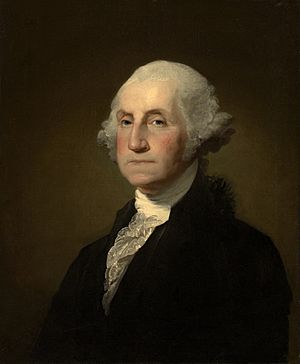
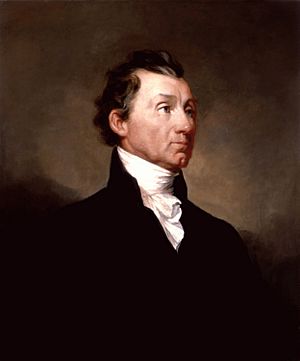
The first President of the United States, George Washington, really wanted a university to be built in the center of the United States. He often talked to the U.S. Congress about this idea. Washington imagined a university in the new capital city. He hoped it would teach the brightest students from all over the country. He also thought it would benefit from being in Washington, D.C.
George Washington passed away on December 14, 1799. In his will, he left money to help start the university. However, this money later lost its value. So, no school ever received it. After his death, Presidents Thomas Jefferson and James Madison also wanted to make Washington's dream come true.
In 1821, a Baptist minister named Luther Rice gathered money for a college. He got help from James Monroe, John Quincy Adams, John C. Calhoun, and others. They wanted a college to teach young people from across the new nation in Washington, D.C.. A large building was built on College Hill, which is now Meridian Hill Park. On February 9, 1821, President Monroe approved the official document. This document created the non-religious Columbian College. People in Washington, Congress, and educators celebrated this new school. They saw it as making George Washington's dream a reality. In 1824, the first graduation was a big event for the young city. President Monroe, John C. Calhoun, Henry Clay, and the Marquis de Lafayette were all there.
The 1800s at GW
During the 1800s, most students at the university came from the southern states. When the American Civil War began in 1861, many students left to join the Confederate States Army. The college itself was divided. One professor, A. Y. P. Garnett, left to be the doctor for Jefferson Davis. Another, Robert King Stone, stayed in Washington, D.C., and was the doctor for Abraham Lincoln. The college was used as a Union Army military camp for a while during the war. The famous poet Walt Whitman worked at this camp when he visited his injured brother.
In 1873, after the Civil War, Columbian College changed its name to Columbian University. It moved to a city location near 15th and H streets.
The 1900s at GW
In 1904, Columbian University was renamed George Washington University. This happened after an agreement with the George Washington Memorial Association. Money from this group helped build Lisner Auditorium in honor of George Washington.
In 1912, the university moved most of its operations to the Foggy Bottom area of Washington, D.C. Many of GW's schools are very old. The law school is the oldest in D.C. The medical school is the 11th oldest in the nation and the first in the capital. Columbian College, founded in 1821, is the oldest part of the university. The Elliott School of International Affairs officially started in 1898.
In the 1930s, the university was a major place for studying theoretical physics. George Gamow, a scientist who studied the universe, developed the Big Bang theory at the university in the 1930s and 1940s. On January 26, 1939, Niels Bohr announced that Otto Hahn had successfully split the atom. This happened at a physics conference in the Hall of Government.
During the Vietnam War era, Thurston Hall, a student dorm, was a meeting point for student protests against the war. It was only three blocks from the White House.
In 1996, the university bought the Mount Vernon College for Women. This became the co-educational Mount Vernon Campus. It was first used in 1997 for women only. But it became co-ed a few years later. The Mount Vernon campus is now fully part of the GW community. It works with the Foggy Bottom campus. In 1999, GW hosted a "Town Hall with President Clinton." This was the first time a presidential town hall meeting was shown live on the internet.
| College/School | Year founded |
| Arts and Sciences | 1821 |
| Medicine | 1824 |
| Law | 1865 |
| Engineering | 1884 |
| Arts and Design | 1878 |
| Education and Human Development | 1909 |
| Business | 1928 |
| Media and Public Affairs | 1938 |
| Political Management | 1987 |
| Public Health | 1997 |
| Professional Studies | 2001 |
| Public Policy and Public Administration | 2003 |
| Nursing | 2010 |
The 2000s at GW
In December 2006, Steven Knapp became the 16th president of GW. He started his role on August 1, 2007. In 2017, Thomas LeBlanc was named the next president.
In July 2020, the university started looking at changing the names of a campus building and the school's nickname. President LeBlanc said one group would look at the "Colonials" nickname. Some people felt this name brought up ideas of racism and violence. In 2022, the "Colonials" name was officially stopped. In 2023, the new nickname, the George Washington Revolutionaries, was announced. Another group looked into renaming the Marvin Center. It was named after former president Cloyd H. Marvin, who supported racial segregation.
In January 2022, Mark S. Wrighton became the interim university president. Then, in January 2023, Ellen Granberg was named the university's new president. She started on July 1, 2023. George Washington University joined the Association of American Universities in 2023.
GW Campuses

GW has three main campuses in the Washington, D.C. area. These are the Foggy Bottom campus, the Mount Vernon campus, and the Virginia Science and Technology campus. Most of the classes and academic programs are at the Foggy Bottom Campus. There are dorms for students on both the Foggy Bottom and Mount Vernon campuses.
The GW library system includes several libraries. These are the Gelman Library, the Himmelfarb Health Sciences Library, the Burns Law Library, Eckles Library, and the Virginia Science and Technology Library. The GW Library System is part of a group called the Washington Research Library Consortium. This group allows libraries in the Washington area to share resources.
Foggy Bottom Campus

The main GW campus is about 43 acres in the historic Foggy Bottom area. It is just a few blocks from the White House, the World Bank, and the National Mall. The university owns much of the land in Foggy Bottom. It leases some of it to groups like the World Bank. Other important places nearby include the U.S. State Department and the Kennedy Center.
The University Yard is the main open space and the historic center of the university. The Gelman Library, GW's main library, is also here. The Gelman Library building has seven floors and over two million books. It is built in a style from the 1970s. For most of the year, parts of the library are open 24 hours a day for students and staff. The seventh floor has special research collections.
Near the library is Lisner Auditorium. A large open area between them is called Kogan Plaza. The Foggy Bottom–GWU Washington Metro station is right on campus. It gives access to the Orange, Blue, and Silver Metro lines. The University Hospital is next to the Metro station.
The Foggy Bottom campus has most of the dorms where GW students live. Some well-known ones include Thurston Hall and District House. District House opened in 2016.
In 2014, the university took over the Corcoran Gallery of Art. This was the oldest private art museum in Washington, D.C. The art and design college became The Corcoran School of the Arts and Design. Many of the Corcoran's art pieces went to the National Gallery of Art. In May 2014, GW opened the Milken Institute School of Public Health. This nine-story building is designed to be very energy efficient. The Textile Museum reopened in March 2015. It had joined the university in 2011.
Mount Vernon Campus
In 1996, GW bought the Mount Vernon College for Women. This campus is in the Palisades neighborhood. It became a co-educational campus for GW. It was bought to give the university more space, especially for sports teams like women's soccer. Now called the Mount Vernon campus, it is fully part of the GW community. It works with the Foggy Bottom campus. There are transportation systems to connect students to the Foggy Bottom campus. It has Eckles Library, six dorms, a gym, and athletic facilities.
Virginia Campus
George Washington University also has a research and graduate campus in Ashburn, Virginia. This campus is near Dulles International Airport and was started in 1991. It began with a gift of 50 acres. By 2010, it had grown to 101 acres. Besides graduate studies, this campus also offers undergraduate programs. These include Health Science, Cybersecurity & Information Technology, and Nursing.
The university also has other smaller graduate education centers. These are in Alexandria, Arlington, and Newport News, Virginia. The Virginia Science and Technology Campus is home to the world's first walking path powered by solar energy. This project started in 2012 and was finished in October 2014.
How GW is Organized
George Washington University is run by its Board of Trustees, the university President, the Provost, Deans, and department chairs. The university has over 6,000 teachers, administrators, and staff. The current President of the George Washington University is Ellen Granberg. Former U.S. President Ulysses S. Grant was on the Board of Trustees. His grandson, Ulysses S. Grant III, was a Vice President of GW. John Quincy Adams, another former president, was also on the board.
Schools and Colleges at GW
| Undergraduate & Graduate Schools of The George Washington University | |||||||
|---|---|---|---|---|---|---|---|
| Columbian College of Arts and Sciences |
School of Business | Elliott School of International Affairs |
Milken Institute School of Public Health |
School of Engineering and Applied Science | School of Nursing | School of Media and Public Affairs | |
| Graduate Schools of The George Washington University | |||||
|---|---|---|---|---|---|
| Graduate School of Political Management | Medical School | Law School | Graduate School of Education & Human Development | Trachtenberg School of Public Policy and Public Administration |
College of Professional Studies |

GW has fourteen different schools and colleges. Each one has its own leader and way of working. The Columbian College of Arts and Sciences was the first part of the university. The Medical School is the 11th oldest medical school in the country. It was the first to open in Washington, D.C. The Law School was also the first law school in D.C. Each school has its own special identity within the university. Some schools, like the Graduate School of Political Management, joined the university later.
Columbian College of Arts and Sciences
The Columbian College of Arts and Sciences (CCAS) is the oldest and largest college at GW. It was founded in 1821. At first, this college and the university were the same thing. The School of Media and Public Affairs (SMPA) and the Trachtenberg School of Public Policy and Public Administration (SPPPA) are part of this college. But they are run separately. Columbian College was one of the first American schools to give out a Doctor of Philosophy (Ph.D.) degree, starting in 1888. This college offers many different majors and courses. It is mainly located in buildings like Philips Hall and Rome Hall on campus. It also has a presence on the Mount Vernon and Virginia Campuses.
Trachtenberg School of Public Policy and Public Administration
The Trachtenberg School of Public Policy and Public Administration is a graduate school within the Columbian College. It is often ranked as one of the top public affairs schools in the U.S. The school offers master's and PhD degrees in public policy and public administration. It also works with other schools to offer different study areas.
School of Media and Public Affairs
The George Washington University School of Media and Public Affairs (SMPA) is part of the Columbian College. It offers degrees in Journalism and Mass Communication and Political Communication. It also has a master's degree in Media and Public Affairs. SMPA was the first school in the nation to offer a bachelor's degree in Political Communication. Its teachers include former CNN reporters, journalists, and political experts.
Corcoran School of the Arts and Design
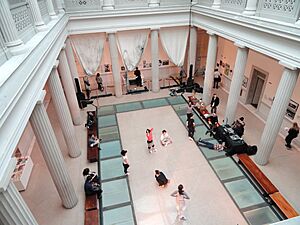
The Corcoran School of the Arts and Design is one of the oldest art schools in the U.S. It is a school within the Columbian College of Arts and Sciences. It is located in the Corcoran Gallery of Art building. This building is the oldest private cultural place in Washington, D.C.. The school used to be independent. But it later joined George Washington University. It kept many of its full-time teachers. The school has a historic building that faces the White House.
School of Business
The George Washington School of Business started in 1928. It received a large gift from a group called the Supreme Council of Scottish Rite Freemasonry. In 2006, the CEO of FedEx, Frederick W. Smith, opened a new building complex for the school. This complex now houses the business school.
In 2018, GW's undergraduate business program was ranked 42nd nationally. Its International Business program was ranked ninth by U.S. News & World Report.
School of Medicine and Health Sciences
The George Washington University School of Medicine and Health Sciences (SMHS) was founded in 1824. It was the first medical school in Washington, D.C.
In 1981, George Washington University Hospital became famous when President Ronald Reagan was taken there after an attempted attack. The hospital's emergency room was later named the Ronald Reagan Institute of Emergency Medicine. Other politicians, like former Vice President Dick Cheney, have also received medical care at GW. The medical school is mainly located in the GW Hospital and Ross Hall.
School of Engineering and Applied Science
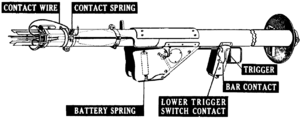
The George Washington University School of Engineering and Applied Science (SEAS) started on October 1, 1884. It was first called the Corcoran Scientific School. The school became separate from Columbian College in 1962. It was one of the first engineering schools to accept women for degrees. The bazooka was invented at SEAS in 1942. The school moved into the new Science and Engineering Hall in D.C. in March 2015.
Elliott School of International Affairs
The Elliott School of International Affairs (ESIA) was founded in 1898. It was first called the School of Comparative Jurisprudence and Diplomacy. In 2003, former student Colin Powell opened a new building for this school. As of 2015, its undergraduate program was ranked eighth globally by Foreign Policy magazine. Its graduate program is ranked seventh in the world. ESIA is mainly located in Elliott Hall.
School of Nursing
Nursing education at GW has a history of over 100 years. In 2010, the GW School of Nursing was re-established. It is now the university's tenth academic school.
Law School
The George Washington University Law School was started in 1826. It is the oldest law school in the District of Columbia. Several Supreme Court Justices have taught there. The law school is mainly located on the east side of University Yard.
Graduate School of Education and Human Development
Teaching education has been offered at GW since 1904. The education part became a separate school in 1909. It was called the Teachers' College. In 1994, it became the Graduate School of Education and Human Development. This showed its focus on graduate-level education.
College of Professional Studies
The George Washington University College of Professional Studies (CPS) was founded during the time of President Trachtenberg. The The Graduate School of Political Management is part of this college. CPS offers classes on both the Foggy Bottom and Virginia campuses.
Graduate School of Political Management
The The Graduate School of Political Management (GSPM) is part of the College of Professional Studies. GSPM offers graduate degrees in areas like legislative affairs and political management.
Milken Institute School of Public Health
The Milken Institute School of Public Health started in July 1997. It was renamed in March 2014. It brought together three older university programs. Today, over 900 students from many countries study public health here. Its student body is very diverse. The school also offers programs where students can earn two degrees at once.
Academics at GW
| Undergraduate | Graduate | U.S. (2020) | |
|---|---|---|---|
| White | 49.29% | 41.29% | 57.84% |
| Asian | 14.95% | 11.11% | 5.92% |
| Hispanic | 13.09% | 7.83% | 18.73% |
| Black | 7.65% | 12.06% | 12.05% |
| Two or More Races | 5.48% | 2.95% | 4.09% |
| American Indian | 0.05% | 0.17% | 0.68% |
| Pacific Islander | 0.07% | 0.13% | 0.19% |
| International | 7.68% | 19.19% | N/A |
| Unknown | 1.73% | 5.28% | N/A |
| Male | 36.80% | 39.50% | 49.50% |
| Female | 63.20% | 60.50% | 50.50% |

Applying to GW
GW is the largest university in Washington, D.C. About 10,000 full-time undergraduate students and 14,000 graduate students attend. These students come from all 50 states and over 120 countries. Nearly 900 students study abroad each semester in 50 different countries. As of 2015, George Washington University no longer required SAT and ACT test scores for applicants. This was done to help more students from different backgrounds apply.
The tuition rate for the 2021–2022 school year was $59,780. Students received $308.1 million in financial aid during the 2017–2018 school year. For students starting in 2011, the student loan default rate was very low, at 1.4%. This means very few students had trouble paying back their loans. For the 2010–2011 school year, 94.3% of freshmen returned for their second year. GW requires undergraduate students to live on campus for their first two years.
In September 2013, the student newspaper The GW Hatchet reported that the university considered a student's ability to pay when making admissions decisions. This was different from what the university had claimed. GW later admitted that its admissions policy did consider a student's financial need.
Student Enrollment
During the 2013–2014 school year, many students were enrolled in different colleges. For example, 5,015 undergraduates were in the Columbian College of Arts and Sciences. 2,005 were in the Elliott School of International Affairs.
Students come from all 50 U.S. states. Many students come from New York, California, New Jersey, and Pennsylvania. George Washington University also has many international students. In the 2013–2014 school year, students came from over 130 countries. The most common countries were China, South Korea, India, and Saudi Arabia.
Rankings and Reputation
| ARWU World | 301–400 |
|---|---|
| THES World | 201–250 |
| USNWR National University | 63 |
| Washington Monthly National University | 28 |
| Forbes | 67 |
U.S. News and World Report ranked GW tied for 63rd among National Universities in 2024. Washington Monthly ranked GW 28th in its "2024 National University Rankings." Forbes ranked GW 67th in 2025.
- Past Admissions Data
In 2012, GW announced that it had reported incorrect admissions data for over ten years. The university had overstated how many students graduated in the top ten percent of their high school classes. This was due to a "data reporting error." Because of this, U.S. News & World Report temporarily removed GW from its rankings. The university was put back in the rankings a year later in 2014.
- Program Rankings
The Princeton Review ranked GW first for "Top Colleges or Universities for Internship Opportunities." GW is often ranked as one of the "Most Politically Active" Schools by The Princeton Review.
U.S. News & World Report ranks GW's international business program as eighth best in the world. Its MBA program is 51st best, and its undergraduate business program is 38th best.
Foreign Policy magazine ranks the Elliott School's Masters in International Affairs as the seventh best in the world in 2018. It also ranks the Elliott School as eighth in the "Top U.S. Undergraduate Institutions to Study International Relations 2018."
U.S. News & World Report ranks the Trachtenberg School of Public Policy and Public Administration as the 10th best public affairs school in the U.S.
The 2020 U.S. News & World Report ranks GW Law School as fifth best in the U.S. for its international law program. It is also ranked fifth best for intellectual law and 22nd best overall.
Research at GW
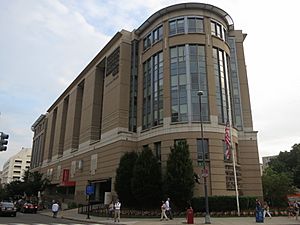
George Washington University is the largest research university in Washington, D.C.. In 2018, the university spent $260 million on research and development. This ranked it 89th in the nation. In 2023, GW was invited to join the Association of American Universities.
Research Centers and Institutes
George Washington University has many research centers and institutes. These include:
- Centers
- Sigur Center for Asian Studies
- Center for the Advanced Study of Human Paleobiology
- GW Cancer Center
- Center for Aging, Health, & Humanities
- Center for Equity and Excellence in Education
- GW Institute for Biomimetics and Bioinspired Engineering
- Center for Otolaryngology Microsurgery Education & Training (COMET)
- The Dr. Cyrus & Myrtle Katzen Cancer Research Center
- McCormick Genomic and Proteomic Center (MGPC)
- National Crash Analysis Center
- Biostatistics Center
- Regulatory Studies Center
- Center for the Connected Consumer
- The Project on Forward Engagement
- GW Project on Extremism
- Eleanor Roosevelt Papers Project
- Jackie Robinson Project
- First Federal Congress Project
- The Gill-Lebovic Center for Community Health
- Institutes
- Institute for International Economic Policy
- Institute for Public Diplomacy and Global Communication
- Institute for Security and Conflict Studies
- Institute for International Science and Technology Policy
- Institute for Global and International Studies
- Institute for Disaster and Fragility Resilience
- Institute for European, Russian, and Eurasian Studies
- Institute for Middle East Studies
- Institute for African Studies
- Institute for Korean Studies
- Cisneros Hispanic Leadership Institute
- George Washington Institute for Neuroscience
- George Washington Institute for Public Policy
- GW Cancer Institute
- GW Solar Institute
- GW Institute for Biomedical Sciences
- GW Institute for Biomedical Engineering
- Rodham Institute
- Ronald Reagan Institute of Emergency Medicine
- Space Policy Institute
- Institute for Politics, Democracy & the Internet
- Institute for Security and Conflict Studies
- Computational Biology Institute
- Institute for Biomedical Engineering
- Jacobs Institute of Women's Health
- Washington Institute of Surgical Education (WISE)
- Global Food Institute
University Press
The George Washington University Press was a publishing house connected to George Washington University. It started in 1934. Its first book was Modern Hispanic America. The last major book it published was A Medical Center in 1973.
Student Life at GW
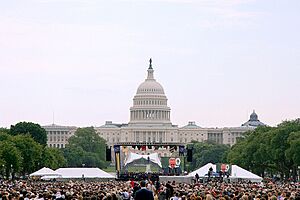
The university is in downtown Washington, D.C. It is close to the Kennedy Center, embassies, and other cultural places. Students at GW are known for being very involved in politics.
GW has a Division I sports program. This includes men's baseball, basketball, cross country, golf, and soccer. It also has women's lacrosse, rowing, softball, swimming, tennis, and volleyball. Men's water polo is also offered. The Revolutionaries sports teams play in the Atlantic 10 Conference. The Division II men's and women's Rugby Teams play in the Potomac Rugby Union.
Student Organizations
Most student groups are run through the George Washington University Student Association (SGA). The SGA is set up like the U.S. government, with executive, legislative, and judicial branches. There are over 500 registered student organizations on campus. The GW College Democrats is the largest student group. They have hosted speakers like CNN contributor Donna Brazile. The GW College Republicans is the largest chapter of its kind in the nation. They have been visited by politicians like former Florida Governor Jeb Bush. The International Affairs Society (IAS) runs the university's highly-ranked Model United Nations team. They also host Model UN conferences for high school and middle school students.
There are also several singing groups on campus. The GW Sons Of Pitch are GW's only male a cappella group. The co-ed GW Troubadours have been on campus since the 1950s. The GW Pitches, an all-female group, started in 1996. The GW Sirens and the GW Motherfunkers are other popular groups. Each year, these groups compete in the "Battle of the A-Cappella groups."
Another student group is the Emergency Medical Response Group (EMeRG). This group provides a free, all-volunteer ambulance service 24/7 for the campus and the local community. EMeRG has been active since 1994. They also help at special events in D.C., like marathons and graduations.
Greek Life
GW has a large Greek community. Over 3,000 students are part of fraternities and sororities. This is almost 27% of the undergraduate students. These groups are managed by different councils. There are also "Alternative Greek Life" groups. These are professional, community service, or honor groups. They are considered separate student organizations.
Scholarly Societies
There are many academic groups at the university. The local chapter of the Society of Physics Students once had famous scientists like George Gamow and Edward Teller involved. The Enosinian Society, founded in 1822, is one of the university's oldest student groups. Famous speakers like Daniel Webster have visited it.
Campus Media
There are four main news sources on campus. These are the independent student newspaper The GW Hatchet, the online publication The Rival GW, the online radio station WRGW, and the university's official news source GW Today. GW also publishes The International Affairs Review, a journal run by graduate students.
WRGW
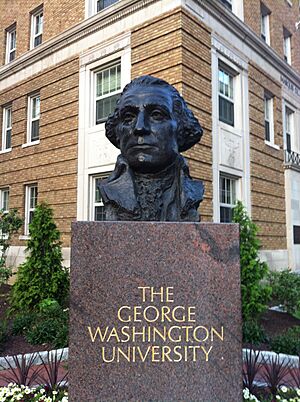
WRGW is the student-run radio station of George Washington University. It broadcasts live online every day during the school year. The studio is in the University Student Center. It has been there since 1999. The online broadcasts are named after a radio station that first started on campus in 1958. That station was created by GWU's Radio Club, which began in 1929.
Environmental Sustainability
George Washington University was ranked number 12 on The Sierra Club's "Cool Schools List" for 2014. It was also in the Princeton Review's Guide to 322 Green Schools for 2013. The campus has a program to make buildings energy efficient. It also has nine buildings that are LEED-certified. This means they are designed to be environmentally friendly. In 2016, university officials did not agree to student demands to stop investing in fossil fuels.
Religious Organizations
George Washington University has an active Newman Center. This center supports the growing Catholic student community on campus.
GW Hillel serves over 3,000 Jewish students. It is one of the largest campus Hillel International organizations in the U.S. In 2021, a multi-story building for Hillel was built in the middle of GW's campus.
GW Athletics
George Washington University is part of the Atlantic 10 Conference. Most of its teams play at the NCAA Division I level. All indoor sports play at the Charles E. Smith Center on the Foggy Bottom campus. Outdoor events are held at the Mount Vernon campus Athletic Complex. The university's colors are buff and blue. These colors were taken from George Washington's uniform during the Revolutionary War.
The official fight song is "Hail to the Buff and Blue". It was written in 1924 by GW student Eugene F. Sweeney. The song is played twice a day by bells on top of Corcoran Hall.
Baseball
The GW baseball team started in 1891. It is part of the Atlantic 10 Conference. The team plays its home games at Barcroft Park in Arlington County, Virginia.
Football
The university had a college football team from 1881 to 1966. The team played home games at Griffith Stadium and later at Robert F. Kennedy Memorial Stadium. In 1966, the football program was stopped. This was because there were not enough good facilities. The university also wanted to build an on-campus fieldhouse for basketball and other sports. GW has one former player in the Pro Football Hall of Fame, Tuffy Leemans.
Men's Basketball
The George Washington Revolutionaries men's basketball team is coached by Chris Caputo.
Men's Soccer
Softball
Spirit Programs
The GW Spirit Program includes a Cheer Team, the First Ladies Dance team, and the university mascot. The Revolutionaries mascot is named George. A student dresses up as General Washington for this role. In 2012, George won first place at the National Cheerleaders Association Mascot Competition. The spirit program also includes the GW Brass band.
Women's Basketball
Club Sports
The university also has many club sports. These are not varsity sports, but they compete against other colleges. Examples include: boxing, basketball, volleyball, ice hockey, figure skating, fencing, lacrosse, rugby, soccer, triathlon, tennis, ultimate frisbee, cricket, Brazilian jiu-jitsu, water polo, and equestrian.
Notable People from GW
Famous Alumni
- Notable George Washington University alumni include:
-
William Greenleaf Eliot, founder of Washington University in St. Louis; Columbian College, 1831
-
Hsu Mo, founding judge of the International Court of Justice; Law School
-
Belva Ann Lockwood, first woman to argue before the U.S. Supreme Court; Law School
-
Syngman Rhee, first president of South Korea; Columbian College, '07
-
J. Edgar Hoover, first FBI Director; Law School, '16
-
John Foster Dulles, 52nd U.S. Secretary of State; Law School
-
Jacqueline Kennedy Onassis, former First Lady of the United States; Columbian College '51
-
L. Ron Hubbard, founder of a religious movement; Columbian College
-
Colin Powell, General and Secretary of State; School of Business
-
Lee Kun-hee, Chairman of Samsung; School of Business
-
Elizabeth Warren, Senator from Massachusetts; Columbian College
-
William Barr, U.S. Attorney General; Law School
-
David Lynch, Director and Artist; Corcoran School
-
Alec Baldwin, Actor; Columbian College
-
Kerry Washington, Actress; Corcoran School
Many famous people have graduated from George Washington University. These include 16 foreign heads of state or government, 28 U.S. senators, and 27 United States governors. Five Nobel Prize winners, two Olympic medalists, and two Academy Award winners are also alumni.
Former students have held many political roles. These include former U.S. Attorney General William Barr and former Secretary of State Colin Powell. J. Edgar Hoover, the first FBI Director, also went to GW.
In business, notable alumni include Lee Kun-hee, former Chairman of Samsung. Scott Kirby is the CEO of United Airlines. Kathy J. Warden is the President and CEO of Northrop Grumman.
In science and technology, alumni include Julius Axelrod, a Nobel Prize winner and medical researcher. Ralph Asher Alpher, a physicist, was called the "father" of the Big Bang theory. Seven NASA astronauts are also alumni.
In arts and entertainment, writer and filmmaker William Peter Blatty, who wrote a famous novel that was made into a movie, is an alumnus. Emmy-winning actors Alec Baldwin and Kerry Washington also went to GW. Filmmaker David Lynch and Oscar-winning actor Jared Leto attended the Corcoran School of the Arts and Design.
Leaders of other universities include William Greenleaf Eliot, who helped start Washington University in St. Louis. Derek Bok was president of Harvard University.
Well-known athletes and sports figures include Boston Celtics coach Red Auerbach. Many players have been drafted into the NBA, like Yinka Dare and Yuta Watanabe. Other notable athletes include WNBA star Jonquel Jones and Olympic medalist Elena Myers. Several alumni have owned sports teams, such as Ted Lerner, who owned the Washington Nationals.
Famous Faculty
- Notable George Washington University faculty include:
-
Edward Teller, physicist known as "the father of the hydrogen bomb"; faculty member
-
José Andrés, award-winning chef; faculty member
-
George Gamow, physicist known for Big Bang Theory; faculty member
-
William J. Crowe, Joint Chiefs of Staff Chairman; faculty member
-
Al Gore, former U.S. vice president; faculty member
-
Clarence Thomas, U.S. Supreme Court Justice; Faculty Member
-
Amy Coney Barrett, U.S. Supreme Court Justice; Faculty Member
-
Ferid Murad, Nobel Prize winner in Medicine; Faculty Member
-
Vincent du Vigneaud, American biochemist and Nobel Laureate; Faculty Member
Many notable people have taught at GW. These include Tom Perez, former Chair of the Democratic National Committee. Two current Supreme Court Justices, Clarence Thomas and Ketanji Brown Jackson, have also been faculty members. George Gamow, who helped develop the Big Bang theory, and Edward Teller, known as the "father of the hydrogen bomb," were also teachers.
Other famous faculty include Vincent du Vigneaud, a Nobel Prize winner in Chemistry. John Negroponte, the first Director of National Intelligence, also taught at GW. Dana Perino, a former White House Press Secretary, and Ferid Murad, another Nobel Prize winner in Medicine, were also faculty.
See also
|


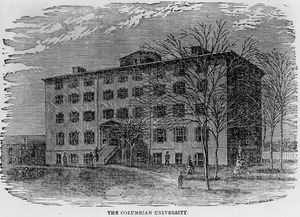


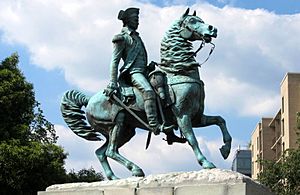

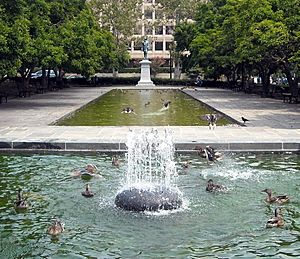
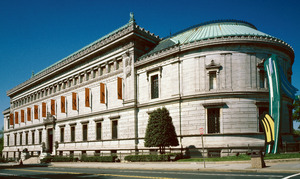
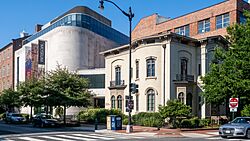
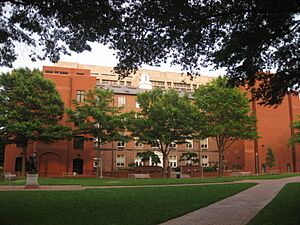
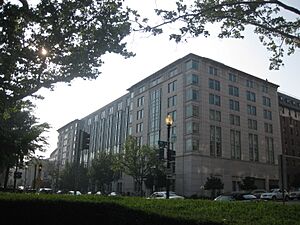

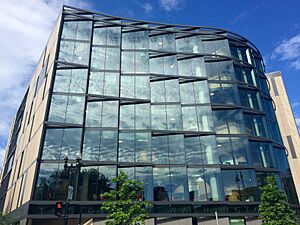
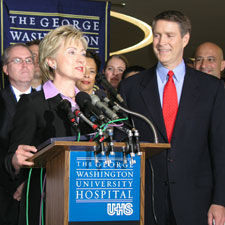

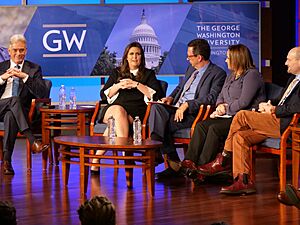

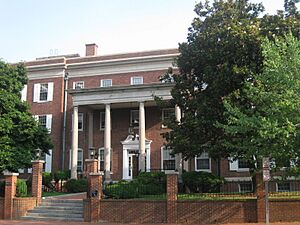

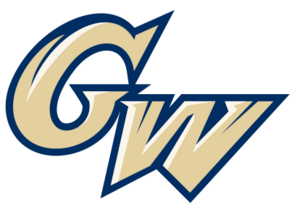
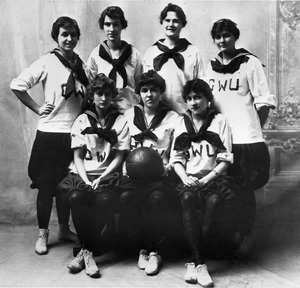
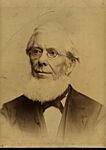


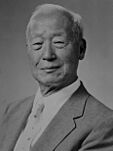
























 In Spanish:
In Spanish: